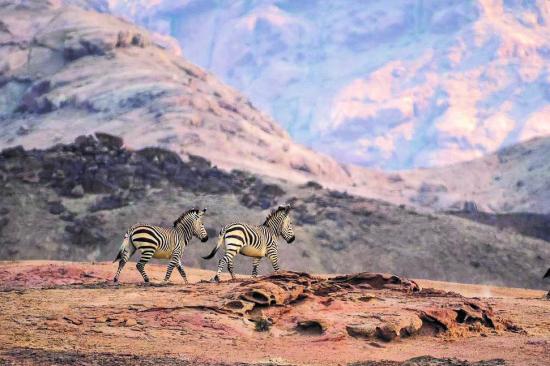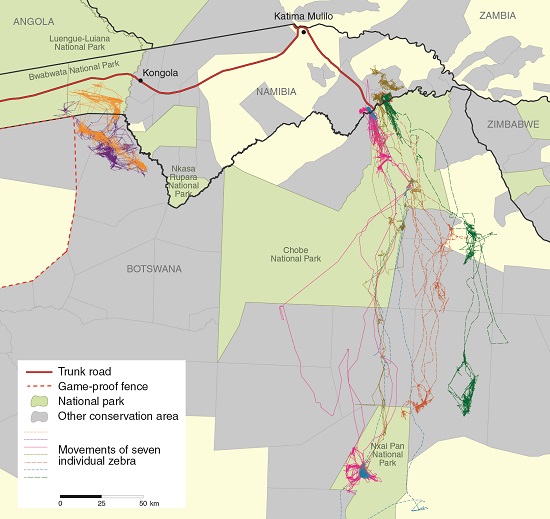Large herbivores
Almost all parts of Namibia support one or more large herbivores as illustrated in the following maps.56 Some are browsers (eating woody vegetation), others are grazers (consuming grasses and herbs), and others are mixed feeders. Some can survive long periods without water, but others need to drink every day. Many of these herbivores are widespread, occurring in protected areas as well as over large areas of freehold and communal lands. Some of these species make seasonal movements in response to environmental conditions, such as drought and rainfall. All are important 'big game' attractions for tourists to Namibia and the majority of them are hunted to provide income as trophy animals or meat for local people. Thus, these species have important monetary value, which often exceeds that of livestock. Their considerable intrinsic appeal also contributes to Namibia's character.
7.38 Distribution of springbok57


Springbok (Antidorcas marsupialis) are widely distributed in Namibia but are most abundant in open habitats with sparse tree cover. They are primarily browsers, feeding on shrubs and succulents, and can survive without drinking even in the harshest desert habitats if their food comprises at least 67 per cent water. The highest densities of springbok are found on the eastern plains of the Namib, in shrubland surrounding Etosha Pan, and in the southeastern regions of the country.
7.39 Movement of springbok up and down the escarpment58

The strongly seasonal nature of rainfall and its variability influence the availability of forage at different times of year and over consecutive seasons. One strategy used by many herbivores to live with these changeable conditions is to follow the rains and move to areas with better forage. Since 2001, annual game counts have been conducted on communal lands in the Erongo and Kunene regions. Rainfall is low here and vegetation cover is particularly variable, especially at the lower altitudes west of the escarpment. This chart shows the proportion of counted springbok sighted below the escarpment over a 19-year period in relation to plant productivity, shown as a vegetation index. The springbok responded to changes in the availability of vegetation by moving down the escarpment in good rainfall years and back up again in drier times.

Photo: S Rankl
7.40 Distribution of kudu59


Kudu (Tragelaphus strepsiceros) ) are found in most parts of Namibia, except the Namib Desert and Cuvelai drainage basin. They are browsers and favour thickets for cover; the highest densities are found in the Acacia Tree-and-Shrub Savanna biome in central Namibia. Relatively few kudu occur in protected areas, with the majority being on freehold farms, especially in areas with thick bush.

Photo: P Lambrecht
7.41 Distribution of hartebeest60


Hartebeest (Alcelaphus buselaphus) predominantly occur in the Acacia Tree and-Shrub Savanna biome in central Namibia. They are gregarious grazers and typically form herds of over 20 animals. They are mainly active in the early morning and late afternoon, resting in shade during the heat of the day. Most of Namibia's hartebeest occur outside protected areas, on freehold farms.

Photo: M Serfling
7.42 Distribution of gemsbok61


Oryx (Oryx gazella), or gemsbok as they are locally known, generally graze but switch to browse when palatable grass is sparse. They do not depend on drinking water and occur throughout most of Namibia, even in areas of true desert. The greatest concentrations are in the central areas and along the edges of the Namib Desert. Along with kudu, they are popular among trophy hunters and their meat is sold by many butchers and restaurants.

Photo: P Lambrecht
7.43 Distribution of giraffe62


Giraffe (Giraffa camelopardalis subspecies angolensis and giraffa) are widely and thinly spread across a broad zone in the central and northern areas of the country. They are browsers, feeding on leaves and twigs of trees, and their distribution largely corresponds to the Acacia Tree-and-Shrub Savanna biome, but also extends into the desert environment below the escarpment.

Photo: M Serfling
7.44 Distribution of Hartmann's zebra63


Hartmann's, or mountain, zebra (Equus zebra hartmannae) is a protected species and Namibia's only endemic large mammal. Its range is largely confined to the escarpment; partly because they are dependent on water that the many springs in the mountains can provide. Hartmann's zebras are grazers and will only browse when there is no alternative. Some individuals move seasonally between summer and winter ranges, while others stay in the same area. The typical social structure is of small breeding groups comprising an adult stallion with a few mares and their dependent young; non-breeding groups consist primarily of bachelors.

Photo: M Serfling
7.45 Distribution of Burchell's zebra64


Burchell's zebra (Equus quagga burchellii) is a plains animal and most of Namibia's Burchell's zebras are in Etosha National Park, on the plains at the edges of the pan. They live in small harems or bachelor groups that often congregate in larger herds around food and water sources. Burchell's zebras also occur in northeastern Namibia and migrate great distances into Botswana (figure 7.47).

Photo: P Lambrecht
7.46 Distribution of elephant65


Elephant (Loxodonta africana) occur in the northwest, in Etosha and in the northeastern areas in and around Khaudum National Park and Zambezi Region. The so-called 'desert elephants' in Kunene Region are at a relatively low density compared to the populations in the northeast. Elephants require extensive areas and travel long distances to find food and water; there are substantial movements of elephant in and out of Zambezi into neighbouring countries as illustrated in figure 7.48. Historically, elephants were found across almost all of Namibia, except in the true desert, but by the beginning of the twentieth century the population was reduced to probably fewer than 1,000 animals as a result of hunting for the ivory trade. There are around 24,000 elephants in Namibia today.

Photo: L Polik
7.47 Burchell's zebra movements around northeastern Namibia66


The map shows the seasonal movements of seven individual adult female Burchell's zebras; each had been fitted with a radio collar in Namibia. Four of them migrated from the floodplains of eastern Zambezi Region, leaving in December, crossing the Chobe River into Chobe National Park in Botswana and continuing southwards to Nxai Pan National Park in central Botswana. Their southward journey took about 15 days. They spent about 10 weeks in Nxai Pan before returning to the Zambezi floodplains. This round trip of over 500 kilometres is the longest known migration of any large mammal in Africa.
7.48 Elephant movements around northeastern Namibia67


Northeastern Namibia is central to the Kavango–Zambezi Transfrontier Conservation Area, the largest transfrontier conservation area in the world. Satellite transmitters fitted to various animals have shown how this large area is connected through the wide-scale movements of large mammals. Here the movements of six elephants are shown. The map illustrates how some move along distinct corridors close to the Kwando River connecting the Sioma Ngwezi National Park in Zambia and the Luengue-Luiana National Park in Angola with national parks, state forest and conservancies in Namibia and Botswana. Such transboundary movements are thought to be essential for these elephants, the largest contiguous population of African elephants in the world, in finding resources for their long-term health and survival.
Tracking studies, such as these, allow us to understand the animals' requirements for resources in different habitats, and how they avoid contact with resident people. Several factors, such as game-proof fences and roads, restrict the free movement of animals, demonstrated by the individual shown in dark blue that seems reluctant to cross the road, and remains south of it, and north and east of the game-proof fence.

